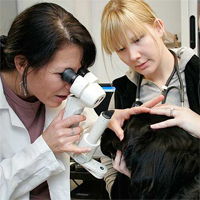Chances are if you’re a dog owner or animal rescue worker the word “circovirus” is cropping up in conversations more and more in recent weeks. Information about this relatively unknown and potentially fatal zoological virus is limited, but that alone can be pretty frightening. Here is what experts know — and what you should, too — about the canine circovirus.
Circovirus in dogs: a somewhat recent development: According to the American Veterinary Medical Association (AVMA), circoviruses have been known to infect pigs and birds in the past. But now the rare and somewhat mysterious virus is making headlines in the Midwest for attacking an entirely different victim — man’s best friend.
The first reported case of the canine circovirus occurred in June 2012, but had been relatively unheard of in dogs since. A confirmed case of the virus cropped up on the West Coast in April of this year when a San Diego dog came down with flu-like symptoms that weren’t improving with traditional treatments.
But canine circovirus has more recently been linked to Ohio dogs. At least eight dogs in the Cleveland and Akron areas of the Buckeye State exhibited circovirus-like symptoms before ultimately passing away. According to the AVMA, the virus has been found in the stool of one of these dogs, but there is not enough evidence to confirm that circovirus is behind this and other dogs’ deaths.
The virus may be spreading: Now, dog owners in Michigan are on edge, with veterinarians in the southeast portion of the state claiming several dogs they have treated exhibited signs of what might be the circovirus before their subsequent deaths.
“Although the Michigan Veterinary Medical Association has not yet released an official statement to confirm the presence of circovirus in Michigan, at EVH we have seen at least four dogs in the past few months that we suspect passed away from this condition,” owner and chief of medicine at the Emergency Veterinary Hospital of Ann Arbor, Dr. Lindsay Ruland, tells The News Herald.
Ruland says she and her clinic staff have seen between 20 to 30 suspected cases since August, mostly dogs, but a few cats, rabbits, and a swan as well.
The list of symptoms isn’t set in stone, but there are some commonalities: “All of the dogs had severe inflammation in their intestinal track, an infected or abscessed pancreas, enlarged abdominal lymph nodes and exhibited varying degrees of lethargy, vomiting, and diarrhea,” Dr. Ruland says.
Any pet exhibiting these symptoms should receive medical intervention right away. It’s better to be safe than sorry, as Dr. Ruland explains.
“We want to alert people that, although we do not know what this condition is or if these cases are related, any animal (dog, cat, rabbit, bird) that exhibits signs of significant lethargy, anorexia, abdominal pain, vomiting or diarrhea— especially if there is blood in it or they appear to have an upper respiratory infection — needs to be evaluated by a veterinarian immediately.”
Dogs that have come down with these symptoms get severely ill within hours because their blood vessels will leak fluid, thickening their blood so nutrients can’t get to vital organs, Dr. Ruland explains. For animals who do not receive treatment or receive treatment too late in the progression of the illness, the symptoms could prove fatal.
Circovirus: is it really behind these deaths? Michigan State University’s Diagnostic Center for Population and Animal Health released a statement announcing that circovirus was found in two canine samples submitted to them by Michigan veterinarians.
The trouble is, several other organisms were found in those same samples as well, making it difficult for experts in the state to determine if circovirus really is behind these dogs’ deaths.
“This is like nothing we’ve ever seen before, and I don’t know if it’s multiple viruses in combination or just the circovirus,” Dr. Ruland told The Columbus Dispatch earlier in the week.
Chairman of the Ohio State University Veterinary Biosciences Department, Dr. Mike Oglesbee, is also in the process of studying the circovirus, which he says hasn’t yet been studied enough to yield conclusive answers about what is making dogs in Ohio and Michigan so sick.
“The relationship to the canine circovirus is unknown,” Dr. Oglesbee says. “It’s a priority to dig down into this, but we’re at step zero.”
There may be a human connection to the virus, too: Though tests have not confirmed this, Dr. Ruland believes there may be a chance that humans and dogs are passing the illness one another. The virus started showing up in Ohio and Michigan around August, which is the traditional start to the human flu season, and many of the sick canines have been showing those flulike symptoms. Dr. Ruland has noticed that canines who have come down with the virus also have owners who are sick.
“Traditionally we don’t pass viruses to our pets,” Dr. Ruland tells WXYZ. “This year, I think that there is potential that we are passing it to our pets.”
The owner of one dog Ruland had treated for potential circovirus, Aarika Pederson, told Dr. Ruland she had started feeling sick around the same time her dog, Brutus, lost his appetite and became lethargic.
“I’ve had this stomach pain that just comes, that’s right beneath my ribs,” Pederson describes.
U.S. vets doing their best to learn more and prepare for circovirus outbreaks: Even though the illness seems centralized in the Midwest, veterinarians across the country are expressing their concerns about the canine circovirus.
Dr. Mark Reser of Harvest Hills Vet Hospital in Oklahoma tells KFOR-TV Oklahoma City that he and his colleagues in the Sooner State and beyond are doing what they can to learn as much about the disease as possible.
“We feel a bit uncomfortable,” Dr. Reser admits. “We don’t know all of the symptoms that might go along with it.”
There is no need to panic, just a need for caution: According to the AVMA, there are a few things pet owners should keep in mind as news of this mysterious illness continues to proliferate. There is no vaccine for the circovirus at this time, so the best thing you can do for your dog is to take preventative measures.
Follow good sanitation and hygiene protocols. Keep your hands clean, and make sure to properly disinfect any areas of your home where dogs might have been.
Monitor your dog for signs of an illness, circovirus or not. If you know your dog is sick, don’t bring him to places where he will be interacting with other dogs because that could only spread the illness. Limiting or prohibiting contact with sick dogs is key.
Some dogs can shed circovirus in their stool, the AVMA explains, even if they aren’t exhibiting signs of the illness. The risk to dogs who are exposed to the circovirus through stool is still unknown at this point, but it’s a good idea for all dog owners to take responsibility and pick up after their dogs.
And lastly, stay educated. As more studies are conducted about the circovirus and about what is behind the deaths of dogs in Ohio and Michigan, it is important to stay up-to-date so you can make the right choices for your pets.
Sources: American Veterinary Medical Association, The News Herald, The Columbus Dispatch, WXYZ









